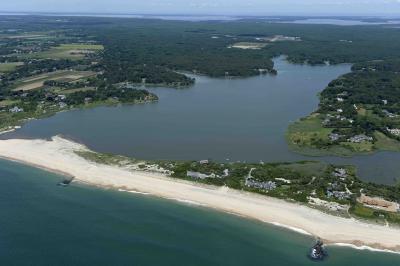Thrice Around the Head
Thrice Around the Head

Modern surf fishermen rely on rods manufactured with high-performance carbon fibers, reels built with aerospace gear technology, and lines created in chemistry labs to catch fish. Things were a little different at the dawn of surf fishing in Montauk.
The preferred method of surf angling in the early to mid-1800s was to attach a long length of coiled silk or linen line to a “squid,” a block of tin embedded with a large hook, and then spin it around and around above one’s head until the squid acquired enough velocity to be launched a fair distance into the surf. Then the fisherman would retrieve the squid hand-over-hand quickly across the surface of the water to entice a strike from a striped bass lurking below. Sometimes anglers would dispense with the tin block and simply toss a hook baited with a squid or crab into the roiling surf.
Montauk practitioners of this surf-fishing technique often tied eel or bass belly skin around the tin block to increase their luck. This heaving and hauling style of fishing required skill as well as substantial strength and endurance. Clearly it was effective. Reports at the time indicate that early surfcasters caught numerous large striped bass. How many fishermen injured themselves or others while wildly swinging the tin block was not recorded.
Later in the 1800s American companies began building long, sturdy rods from hardwoods and simple multiplier bait-casting reels suitable for catching striped bass and bluefish from the shore. This handmade equipment was expensive and was primarily purchased by wealthy members of the many elite striped bass angling clubs that dotted the coast from New Jersey to Maine.
The rods of the early 1900s were strong but not particularly effective for long-distance casting. Resourceful anglers offset the limited reach of their equipment by building casting platforms that extended over the surf. One Montauk catwalk was 2 feet wide, stood 10 to 15 feet above the waves, and jutted 75 feet into the water, according to reports. The wobbly structure was supported by thin pieces of oak wedged between rocks scattered about the shoreline. Other local fish stands were likely of more rugged construction, consisting of thick wood planks resting on a frame of metal pipes set deep into holes that were drilled into large shoreline boulders.
“Modern surfcasting at Montauk undoubtedly was pioneered by Leroy Edwards of East Hampton during the period 1918-19 or 1920,” wrote Richard Gilmartin, a Montauk historian quoted by the Montauk Guide and Cook Book, published in 1959 by the Montauk Chamber of Commerce. Gilmartin contended that Edwards inspired future surfcasting legends including Frank Tuma and Lou Cihlar, then stationed at the Ditch Plain Coast Guard Station, to take up the sport. “These early surfcasters used split-bamboo rods with VomHoff, Perez, or Cozone reels, which held up to 400 yards of line. For many years their terminal tackle consisted exclusively of a single hook, imbedded in a lead jig which weighed up to five and a half ounces,” Gilmartin penned. Whether or not Edwards deserves this honor can be evaluated by those most knowledgeable about the local history of the sport.
Surf fishing certainly has come a long way in nearly 200 years, but in some ways it remains the same. The block of tin with a hook is no different from a Hopkins or other slug of shiny metal hurled by surfcasters today. The old fishing stands allowed an angler to extend the reach of his cast, which also describes the reason why some surfcasters now slip on wetsuits and swim to distant rocks. In the end, and at the End, Montauk surf fishermen have always used whatever tools are available to them as well as their great ingenuity to catch fish.
Harvey Bennett at the Tackle Shop in Amagansett reported that a 41-pound striped bass was taken at Indian Wells Beach and porgies can be found off the fishing pier at the Navy Road park in Montauk. Bennett also mentioned that a gentleman purchased a new surf rod and reel from him, but was uninterested in learning how to cast because he was using a drone to deliver the bait beyond the surfline. (Author shakes head. Sighs.)
Sebastian Gorgone at Mrs. Sam’s Bait and Tackle in East Hampton reported that snappers are here for the poppin’ and some relatively rare and fine-tasting kingfish were taken around Gerard Drive.
Paul Apostolides at Paulie’s Tackle in Montauk said that favorable east winds brought big stripers to surfcasters for a few days, but action largely has returned to bluefish.
T.J. at Gone Fishing Marina in Montauk said that sea bass, fluke, and porgy fishing continue to be strong at Frisbees and other usual spots. Striped bass fishing has eased somewhat with the midmoon. Some bluefin tuna were diamond jigged inshore not far from Cartwright, he added.
Ken Morse at Tight Lines Tackle in Sag Harbor reported a continued strong weakfish bite in Peconic Bay and fluke at the Pocketbook, which is located few miles northwest of Montauk Harbor. Blue-claw crabs can be caught along the shoreline day and night with dipnets, Morse said.








